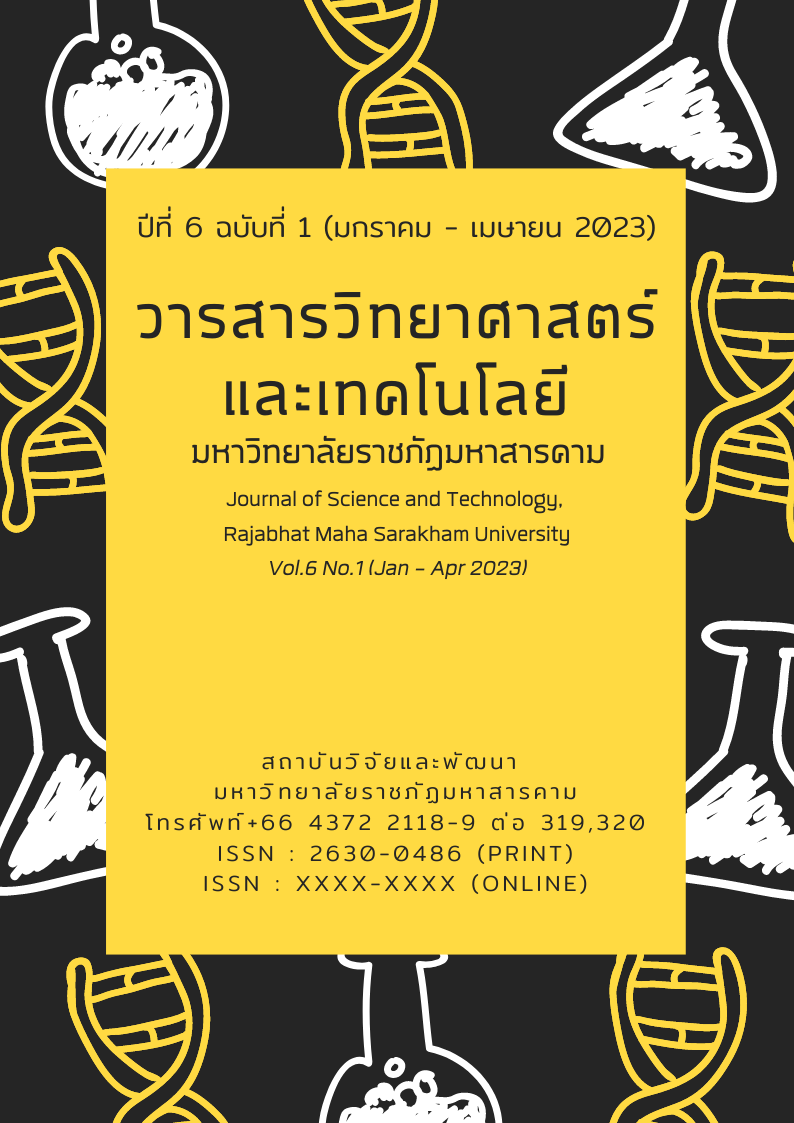Brown rice and Hang rice of Lai Pla Thong variety : Antioxidant activity and Customers acceptance
Keywords:
Hang rice, Lai Pla Thong rice, Antioxidant activityAbstract
Lai Pla thong rice variety is the local rice of Chanthaburi province, with a desirable nature of cooked brown rice that smells like butter but it’s a drawback in hard texture. The texture quality of brown rice is improved by processing it into Hang rice. This research emphasized the antioxidant activity of Brown rice and Hang rice of Lai Pla Thong rice and consumer acceptance of cooked hang rice. The results show that Brown rice extracted has an ash content, protein content, reducing sugar content, and total phenolic content of 2.880 percent, 11.219 g/g extract, 0.0729 mg/g extract, and 17.041 mg GAE/g, respectively, and antioxidant activity with IC50 of 619.257 µg/ml. Hang Rice extracted has a lower protein content (7.633 ± 0.0259 g/g extract) and ash content (2.391 ± 0.0038 percent), whereas exhibits higher reducing sugar content (0.1031±0.0021 mg/g extract) and total phenolic content (17.857 mg GAE/g) than that of brown rice. Additionally, the antioxidant activity with DPPH radical (IC50 = 594.625 µg/ml) of Hang rice is stronger than that of brown rice. Hang Rice cooked has fluffier than that brown rice and it was assessed the sensory evaluation and overall acceptability by the 9-point hedonic scale. The result revealed that the highest acceptability scores were obtained for cooked hang rice at a 1:5 ratio of seeds and water with panelists' moderate preference. These results suggest Lai Pla Thong rice variety is good promising health benefits to consumers and that Hang rice processing improves the color appetizing, texture quality, and remains usefulness on rice, these features are a good selectness for consumers who dislike consuming cooked brown rice.
References
Ang-Lopez, M., Saldana, C., & Carnaje, N. (2016). Effects of steaming on the milling yield, quality, and antioxidant activity of parboiled black rice (Oryza sativa L.). Rice- based biosystems journal, 2, 13-22.
Arsha, R. S., Rasane, P., & Singh, J. (2021). Rice: Bioactive compounds and their health benefits. The Pharma Innovation Journal, 10(5), 845-853.
Chunthanom, P., & Tsai, P.J. (2014). Qualities of Hang rice in North-east area of Thailand. Proceedings of the 11th KU-KPS National Conference. (pp. 1896-1904). Nakhon Pathom: Kasetsart University Kamphaeng Saen Campus
Ghatak, S. B., & Panchal, S. J. (2012). Investigation of the immunomodulatory potential of oryzanol isolated from crude rice bran oil in experimental animal models. Phytotherapy Research, 26, 1701–1708.
Gong, E. S., Luo, S., Li, T., Liu, C., Zhang, G., Chen, J., Zeng, Z., & Liu, R. H. (2017). Phytochemical profiles and antioxidant activity of processed brown rice products. Food Chemistry, 232, 67–78.
Goufo, P., & Trindade, H. (2014). Rice antioxidants: Phenolic acids, flavonoids, anthocyanins, proanthocyanidins, tocopherols, tocotrienols, c-oryzanol, and phytic acid. Food Sciences and Nutrition, 2, 75–104.
Cai, H., Zhang, Q., Shen, L., Luo, J., Zhu, R., Mao, J., Zhao, M., & Cai, C. (2019). Phenolic profile and antioxidant activity of Chinese rice wine fermented with different rice materials and starters. Food Science and Technology, 111, 226-234.
Huang, H., Wang, Z., Aalim, H., Limwachiranon, J., Li, L., Duan, Z., Ren, G., & Luo, Z. (2018). Green Recovery of Phenolic Compounds from Rice Byproduct (Rice Bran) Using Glycerol Based on Viscosity, Conductivity and Density. International Journal of Food Science and Technology, 54(4), 1363-1371.
Hui, C., Bin, Y., Xiaoping, Y., Long, Y., Chunye, C., Mantian, M., & Wenhua, L. (2010). Anticancer activities of an anthocyanin-rich extract from black rice against breast cancer cells in vitro and in vivo. Nutrition and Cancer, 62, 1128–1136.
Imam, M. U., Musa, S. N. A., Azmi, N. H., & Ismail, M. (2012). Effects of white rice, brown rice and germinated brown rice on antioxidant status of type 2 diabetic rats. International Journal of Molecular Sciences, 13, 12952–12969.
Itharat, A., Uttama, S., & Makchuchit, S. (2016). Anti-inflammatory activities of constituents in sang yod rice extracts, γ-oryzanol, vitamins E, B1, B2 and B3, using inhibitory effects on nitric oxide (NO) production in lipopolysaccharide (LPS) activated RAW 264.7 murine macrophage cells. Medicinal & Aromatic Plants, 5, 1–6.
Kerdpiboon, S., & Puttongsiri, T. (2015). Characteristics of Hang Rice and its Cooking. KKU Research Journal, 20(1), 26-33.
Phangphomkul, S. (2020). Germinated Hang rice, Isan wisdom. [Online] https://www.msu.ac.th/msumagaz/smain/readpost.php?mid=37. [November 10, 2022]
Premakumara, G. A. S., Abeysekera, W. K. S. M., Ratnasooriya, W. D., Chandrasekharan, N. V., & Bentota, A. P. (2013) Antioxidant, anti-amylase and anti-glycation potential of brans of some Sri Lankan traditional and improved rice (Oryza sativa L.) varieties. Journal of Cereal Science, 58(3), 451–456.
Rattanasena, P., & Bussaman, P. (2555). Antioxidant activities and total phenolic compound contents in brown rice, pre-germinated brown rice and pre-germinated rough rice of some Thai rice cultivars. Bangkok: The Thai Rice Foundation Under Royal Patronage.
Sanitphol, W. (2020). Local rice varieties Lai Pla Thong, Chanthaburi. [Online]. https:// t.ly/6UeQ. [November 10, 2022]
Sen, S., Chakraborty, R., & Kalita, P. (2020). Rice - not just a staple food: A comprehensive review on its phytochemicals and therapeutic potential. Trends in Food Science & Technology, 97, 265–285.
Sohail, M., Rakha, A., Butt, M. S., Iqbal, M. J., & Rashid, S. (2017). Rice Bran Nutraceutics: A Comprehensive Review. Critical Reviews in Food Science and Nutrition, 57(17), 3771-3780.
Sripum, C., Kukreja, R. K., Charoenkiatkul, S., Kriengsinyos, W., & Suttisansanee, U. (2017). The Effect of Extraction Conditions on Antioxidant Activities and Total Phenolic Contents of Different Processed Thai Jasmine rice. International Food Research Journal, 24(4), 1644-1650.
Tunde, A. (2020). Production of Glucose from Hydrolysis of Potato Starch. World Scientific News, 145, 128-143.



